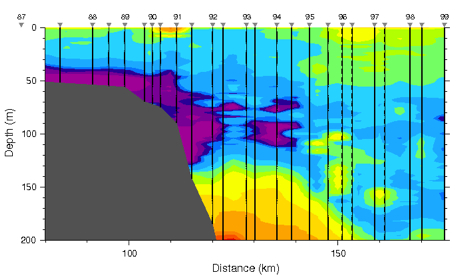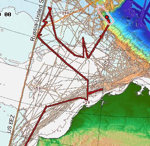July 12, 2011
We’re cruising aboard United States’ newest and most technologically advanced polar icebreaker, and we brought on board fancy equipment with all the bells and whistles to study the Arctic ice and ocean. But it was small low cost probes — used for ocean science since the 1970s — that turned up an interesting event.

The image (above) shows a slice of the Chukchi Sea, where the shallow Continental Shelf drops off into the deep Canada Basin. The temperature gradient ranges from cold winter water (purples and blues) to warm Atlantic water (yellows and oranges). Credit: Bob Pickart/Woods Hole Oceanographic Institution
As you look at the image on your computer, a current would be moving along the shelf pulling the cool, purple water toward you, out of the screen. The question is: how does this cool water reach the deep? Here we caught small-scale turbulent processes in action, forcing blobs of the cold water from the shelf and into the basin.
 |
Data that go into this image demonstrate the mechanism by which blobs of cold winter water are pushed off the shelf into deep basin area. The cold-water blobs bring nutrients for phytoplankton in the basin, and they also provide a cap that prevents warm water from contacting the sea ice.
How is the data collected? The Healy stops at stations for routine deployment the CTD/Rosette sampler, which measures the water’s properties at depth and retrieves samples for testing in the lab. About once a day, teams stop to deploy a full station that calls for deploying a massive suite of instruments. Long hours have made for great progress and today we completed station 100 in just 15 days!
To see what’s happening between stations, however, scientists including Bob Pickart of Woods Hole Oceanographic Institution launch simple, low cost probes called Expendable Bathythermographs (XBTs) while the ship is under way.
MST1 Horace Brittle (right) has launched numerous XBTs from the stern of the Healy. Credit: NASA/Kathryn Hansen
The probe returns temperature and rate of descent data to shipboard recorders along a wire that unspools with the probe. “Picket-fence-like intervals are key for observing small scale turbulent processes, including the blob” said Pickart. “Otherwise we probably would have missed it completely.”

